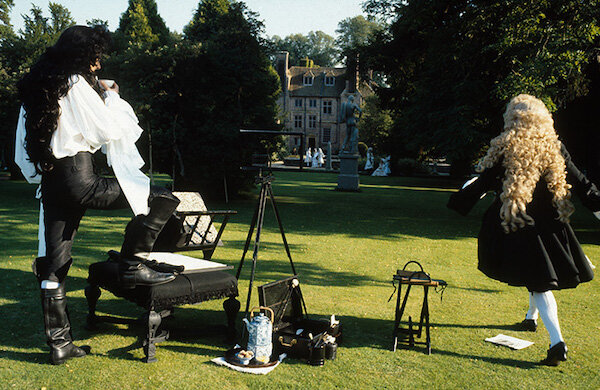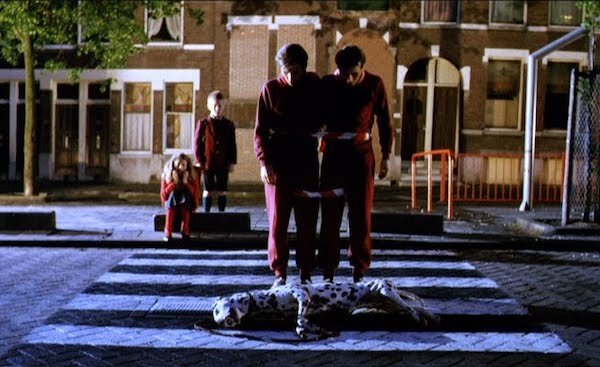Top 5: Peter Greenaway Films
Peter Greenaway is an avant-gardist filmmaker who sought to push the boundaries of cinema, bringing something uniquely striking and fresh to each project, short-form or long. A true pioneer, he continually pushed back against cinema’s traditional narrative structures, something he viewed as an unhealthy entanglement within all visual mediums. With an extensive background in painting, Greenaway was meticulous and particular about framing, set design, and color. Drawing influence from Renaissance, Baroque, and Flemish painting, Greenaway used his settings, performers, framing, dialogue, and sounds like colors on a painter’s palette to create sumptuous compositions ripe with symbolism and intellectual depth.
Controversial and cavalier, his work stands as a true form of Art. It’s impossible to watch a Greenaway film and feel nothing. His films illicit strong reactions, and much like a good painting, they make you think and feel — often times things that defy easy articulation. His obsession with symmetry has inspired the likes of Wes Anderson, and his stylistic artifice was a chief influence on Ari Aster’s Hereditary, but we don’t think Greenaway gets enough praise as he deserves. Simply put: if you haven’t seen a Greenaway film, you’re really fucking up.
Without further ado, here’s our five favorite Greenaway films!
5: The Baby of Macon
The Baby of Macon is perhaps Greenaway’s most unfairly detested and misunderstood masterpieces. This stunning and disturbing medieval drama received several walkouts when it screened at the Cannes Film Festival in 1993 due to its controversial content. Set in 17th century France in the court of Cosimo Medici, the film follows Medici as he and his court watch actors perform a parable about a baby born in the town of Mâcon, a place whose inhabitants have been infertile for a generation. Full of graphic sex and unflinching violence, the film — to us — stands at the level of Ken Russell, Alejandro Jodorowsky, or Stanley Kubrick (specifically A Clockwork Orange), both in style and substance. Needless to say, this grim exploitation fable isn’t for the faint of heart, but we think those who stick with it will find it rewarding.
4: Drowning By Numbers
A notable exercise in form, Drowning By Numbers utilizes number-counting, the rules of games, and the repetitions of the plot as devices to emphasize the film’s structure. Like many Greenaway projects, the general story overview is so odd, it’s hard not to lean in with intrigue. The film's plot revolves around three married women — a grandmother, her daughter, and her niece — each named Cissie Colpitts, who murder their husbands by drowning them. For each incident, the investigating coroner is persuaded to cover up the murders as accidents, under the guise that each Cissie Colpitts promises to sleep with him — a promise that is ultimately never fulfilled. With a structure reminiscent of fairy tales — most notably, The Billy Goats Gruff —and a terrific score by frequent Greenaway collaborator Michael Nyman (which is brilliantly recycled in The Cook, The Thief, His Wife & Her Lover), this beautifully photographed surrealist black comedy is a unique vision full of signature Greenaway hallmarks that we think is pretty unforgettable.
3: The Draughtsman’s Contract
Riding the coattails of Greenaway’s unconventional feature film debut, The Falls, The Draughtsman’s Contract remains as one of his most conventional and accessible pieces of work. Featuring another excellent Michael Nyman score, The Draughtsman’s Contract is a sumptuous period piece in the shape of a murder mystery, and it’s a work of Art that only Peter Greenaway could dream up. Making full use of Greenaway’s painting background, it’s the first film that really solidified Greenaway’s stylistic obsession with symmetry, and much like Kubrick’s Barry Lyndon, every composition is a rich and detailed as a painting from the era it portrays. The visual references for the film are paintings by Caravaggio, de La Tour, Rembrandt, Vermeer and other Baroque artists, and they help to lend the film its perceptible painterly quality. With its compelling central puzzle, erotic overtones, and bleak outlook, The Draughtsman’s Contract is not just a phenomenal early entry in Greenaway’s catalogue, but one of the greatest period dramas ever made.
2: A Zed & Two Noughts
A Zed & Two Noughts (AKA ZOO) is one of Greenaway’s most visually odd and appealing masterpieces. The film is notable for being the first collaboration between Greenaway and cinematographer Sacha Vierny, who Greenaway referred to as his “most important collaborator,” and it would become the first of eight full-length collaborations between the pair — all of which are films selected for this list. The film ranks amongst the oddest of Greenaway’s oeuvre, full of musing on life, love, bad sex, doubling, man's mistreatment of animals, artifice versus life force, and the inevitability of birth, death and decay. Like all Greenaway films, A Zed & Two Noughts is pockmarked with Greenaway’s obsessive tendencies — namely swans, twins, and decay — and we’re absolutely certain that the film was a big influence on David Cronenberg’s Dead Ringers (there are just too many similarities, and Greenaway definitely wears it best). Like nearly all Greenaway films, this one won’t be every cinemagoer’s cup of tea, but those eccentric individuals attuned to Greenaway’s particular idiosyncrasies may very well rank it as arguably his best work — and we’d be inclined to agree, if there weren’t one other Greenaway project that we like just a hair more.
Before we name our favorite Greenaway film, here’s a few honorable mentions:
The Falls
The Pillow Book
Prospero’s Books
Without further delay, our favorite Peter Greenaway movie is…
1: The Cook, The Thief, His Wife & Her Lover
Mixing romance, crime, and revenge, Greenaway created a thoughtful and deliberate masterpiece whose raw emotion and violent interpersonal conflict marked a departure from the cerebral detachment that resides in most of this body of work. In addition to the kind of visuals and grotesqueries that had become typical of Greenaway’s films, The Cook, The Thief, His Wife & Her Lover offered a compelling story — probably Greenaway’s most “conventional” and straightforward narrative since The Draughtsman’s Contract — which dually functions as a surface-level drama or as a scathing attack on Margaret Thatcher. No matter a viewer’s familiarity with Thatcher, The Cook, The Thief, His Wife & Her Lover will undoubtedly get under skin. The film scarred Ari Aster into creating his own brand of scarring dramas. Aster has stated, “I regretted watching it for many years. There’s something so upsetting to me about the level of artifice in this film, from Sacha Vierny’s cinematography to Jean-Paul Gaultier’s costumes. What you’re left with is Greenaway’s wholesale disgust with the human race.” And it sizzles with raw power and emotion, which is why it’s our favorite Peter Greenaway film.
Did we leave your favorite off our list?! We want to know. Share your thoughts and feelings in the comments section below, and as always, remember to viddy well!







